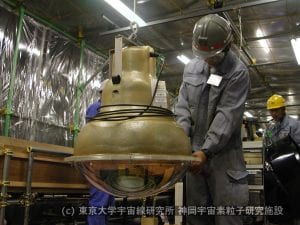
BCIT Faculty members Dr. Barry Pointon and Dr. Michal Aibin recently joined the Canadian Hyper-K group to work with researchers and students involved in the existing Super-Kamiokande (Super-K) and the future Hyper-Kamiokande (Hyper-K) neutrino physics experiments in Japan.
This Canadian collaboration included many Canadian universities and institutions such as BCIT and TRIUMF, Canada’s particle accelerator centre. Recently, $2 million NSERC grants were received for applied research in support of this international, world-class experiment. A portion of this grant will provide opportunities for the BCIT researchers and select students to work on the project.
“I am excited to join the Canadian Hyper-K group. This is an incredible opportunity for BCIT, myself, and our students to work with world-class facilities, and cutting-edge research that led to awarding half of the 2015 Nobel Prize in Physics,” says Dr. Pointon.
“Dr. Pointon’s work with this international group shows the quality and contribution of the applied research done at BCIT. The collaboration has BCIT once again working side by side with world-class international institutions to solve today’s complex problems. We’re very excited and proud of Dr. Pointon’s achievement,” shares Kim Dotto, Dean Applied Research and Centre for Applied Research and Innovation.
Have you subscribed? Sign-up to receive the latest news on BCIT.
Neutrinos, also known as ghost particles
Neutrinos are often called “ghost particles”. They are almost massless sub-atomic particles that travel at near lightspeed and are created by events such as radioactive decay, exploding stars, and gamma-ray bursts. Neutrinos are not only interesting in themselves, but also important as messengers, revealing both subtle and explosive processes in the universe.

Neutrinos are difficult to pin down. They move through lead as easily as we move through air and even though trillions of neutrinos are right now passing easily through the atoms of your body, they are extremely difficult to detect. Enormous detectors are needed to study neutrinos. The only way to find them is when they collide with a water molecule displacing charged molecules and creating light trails called Cherenkov Radiation, which are extremely rare.
The Japanese Super-K contains 50,000 tonnes of water surrounded by approximately 11,000 photo-sensors to detect the Cherenkov light. It is located one kilometer below the earth’s surface, in an old Japanese mine. This is to protect it from cosmic rays that would swamp the neutrino signal.
In August 2018, the Japanese government announced support for the construction of Hyper-K, Super-K’s successor. Hyper-K is planned to be eight times larger and will be located near Super-K. At 20 times the sensitivity of Super-K, Hyper-K will enable the highest sensitivity searches for neutrinos including possibly those produced by exploding stars in nearby galaxies outside our Milky Way.

Photosensors and deep learning
With assistance from Dr. Barry Pointon, the team at Super-K and the future Hyper-K will have better photo-sensors to detect the neutrino interactions and better software to identify those interactions when they happen.
BCIT is a place of applied research, and true to this vein, Dr. Pointon is applying the knowledge he uses to teach his students in BCIT’s Nuclear Medicine Technology program to his work on Super-K and Hyper-K. The Canadian group is developing new photo-sensors based on photomultiplier tubes (PMTs). These turn out to be the same technology used in nuclear medicine SPECT and PET medical imaging cameras for detecting diseases such as coronary artery disease and cancer. The photo-sensor research and development may have some applications back into nuclear medicine.

Dr. Pointon, with BCIT’s Dr. Michal Aibin, will also be using their skills to develop deep-learning tools that will analyse the data collected by the photo-sensors looking for the telltale signs of subtle neutrino reactions that are difficult to detect with existing methods. Unsurprisingly, deep learning is also becoming an important tool in medical imaging to improve patient diagnosis, and an active area of research in nuclear medicine.
Benefiting BCIT students for years to come
The benefits to BCIT students from Dr. Pointon’s research will be numerous and far-reaching for a number of years. BCIT Computer Science students and faculty will be assisting with the deep learning part of the project, beginning with a Computer Science Industry Sponsored Student Project proposal. Further, opportunities for research and development work on the photo-sensors will be made available to Mechanical and Electrical engineering students through Co-op and summer student work as well as Capstone projects. The research process provides a valuable learning experience and has a lasting impact on students exposing them to the research process and allowing them to apply the knowledge and skills they learn as students to a real-world problem.
Dr. Pointon’s work has been supported by BCIT’s Institute Research Funds which allow BCIT employees to pursue research initiatives outside of the regular external granting agencies model by accessing BCIT research funds.
Dr. Pointon will soon take on the responsibilities of running shifts at the experiment in Japan and attending regular collaboration meetings.
Innovative Solutions to Real-Life Problems
Applied research at BCIT is exciting. It creates practical learning opportunities for BCIT’s students, provides innovative solutions to industry challenges, and produces new, commercially relevant technology products and applications.
For more information on applied research at BCIT, please visit us at www.bcit.ca/appliedresearch/.
